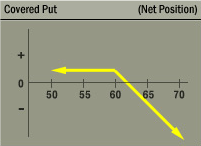Covered Put
This strategy is used to arbitrage a put that is overvalued because of its early-exercise feature.
Description
The idea is to sell the stock short and sell a deep-in-the-money put that is trading for close to its intrinsic value. This will generate cash equal to the option's strike price, which can be invested in an interest bearing asset. Assignment on the put option, when and if it occurs, will cause complete liquidation of the position. The profit would then be the interest earned on what is essentially a zero outlay. The danger is that the stock rallies above the strike price of the put, in which case the risk is open-ended.
Outlook
Looking for a steady to slightly falling stock price during the life of the option. A neutral longer-term outlook isn't necessarily incompatible with this strategy, but a bullish long-term outlook is incompatible.
Summary
This strategy is used to arbitrage a put that is overvalued because of its early-exercise feature. The investor simultaneously sells an in-the-money put near its intrinsic value, sells the stock and then invests the proceeds in an instrument earning the overnight interest rate. When the option is exercised, the position liquidates at breakeven, but the investor keeps the interest earned.

EXAMPLE
- Short 100 shares stock
- Short 1 60 put
MAXIMUM GAIN
- Short sale price - strike price + premium received (interest)
MAXIMUM LOSS
- Unlimited
Motivation
Earn interest income on zero initial outlay.
Variations
This strategy discussion focuses only on a variation that is an arbitrage strategy involving deep-in-money puts. A covered put strategy could also be used with an out-of-money or at-themoney put where the motivation is simply to earn premium. But since a covered put strategy has the same payoff profile as a naked call, why not just use the naked call strategy and avoid the additional problems of a short stock position?
Max Loss
The maximum loss is unlimited. The worst that can happen at expiration is that the stock price rises sharply above the put strike price. At that point, the put option drops out of the equation and the investor is left with a short stock position in a rising market. Since there is no absolute limit to how high the stock can rise, the potential loss is also unlimited. An important detail to note: as the stock rises, the strategy actually begins to incur losses when the Delta of the option starts declining (in absolute terms).
Max Gain
Since the put is deep in-the-money, the maximum gain is limited to interest on initial cash received plus any time value in the option when sold. The best that can happen is for the stock price to remain well below the strike price, which means the option will be exercised before it expires and the position will liquidate.
The profit/loss from the stock is the sale price less the purchase price, i.e., where the stock was sold short minus the strike price of the option. Add to that the premium received for selling the option and any interest earned. Keep in mind that a put's intrinsic value is equal to the strike price minus the current stock price. So if the option was sold for its intrinsic value with regard to where the stock was sold short, exercise of the option results in zero profit/loss (excluding any interest earned).
Profit/Loss
The potential profit is limited to the interest earned on the proceeds of the short sales. Potential losses are unlimited and occur when the stock rises sharply.
Just as in the case of the naked call, which has a comparable payoff profile, this strategy entails enormous risk and limited income potential, and therefore is not recommended for most investors.
Breakeven
The investor breaks even if the option is sold for intrinsic value and assignment occurs immediately. In that case, the option ceases to exist and the short stock position will also be closed out. Should the investor be assigned the same day, cash received from the short sales would be paid out right away, so there would be no time to earn any interest. The assigned stock will be transferred directly to cover the short.
Breakeven = price stock shorted at + premium received
Volatility
An increase in volatility, all other things equal, would have a negative impact on this strategy.
Time Decay
The passage of time will have a positive impact on this strategy, all other things equal.
Assignment Risk
Yes. Since assignment liquidates the investor's position, early exercise simply means that no further interest is earned from the strategy.
And be aware, a situation where a stock is involved in a restructuring or capitalization event, such as a merger, takeover, spin-off or special dividend, could completely upset typical expectations regarding early exercise of options on the stock.
Expiration Risk
Yes. However, the risk is that late news causes the option to not be exercised and the stock is sharply higher the following Monday. A sharp rise in the stock is always a threat to this strategy, and not just at expiration.
Comments
Due to its very limited rewards, unlimited risk potential and the standard complications of selling stock short, this risky strategy is not recommended for most investors. As a practical matter, it is challenging to sell a deep-in-the-money put at its intrinsic value. This strategy is included more as an academic exercise to understand the effects of cost of carry than as an appropriate strategy for the typical investor.
Related Position
Comparable Position: Naked Call
Opposite Position: Protective Put

